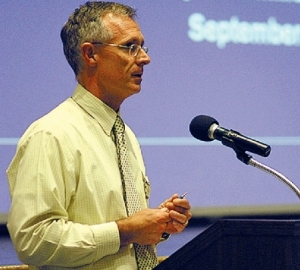Officials talk about H1N1
By Catharin Shepard
Published in News on September 23, 2009 1:46 PM

News-Argus/BOBBY WILLIAMS
Wayne County Health Director James Roosen speaks to a group of residents Tuesday about ways to prevent and contain cases of influenza.
Doctors, public health officials and a state epidemiologist gathered Tuesday night in Goldsboro to share information and to answer questions about preparing for what could become a very busy flu season.
The H1N1 influenza pandemic is coming into its second wave, said epidemiologist Dr. Keith Henderson, and the second wave is usually the worst with the most number of people falling ill during that time. But the news is also good: The H1N1 virus has proven to be even milder than seasonal flu, a vaccine is on the way and should be available by mid-October, and there are other steps people can take to avoid getting the flu.
The first thing to understand is that there are many types of influenza, Henderson said, and not all of them are as dangerous as others.
"You have to have a novel virus to have a pandemic," he explained to the crowd of about 40 people gathered at the Wayne Community College auditorium.
Average flu seasons occur in waves at certain times of the year. Scientists realized something unusual was happening when people began getting sick in April and not during the more probable winter months. Unlike some viruses, H1N1 can survive on a non-porous surface, such as a counter or door knob, for up to 17 hours. That's why frequent handwashing and sneezing or coughing into the crook of an arm, not into cupped hands, is so important, Henderson said.
As it stands, getting the H1N1 virus is not even as big a concern as getting the seasonal flu, since its effects are milder. Even children and the elderly, two groups who typically suffer the most from seasonal flu, have been able to shake it off, Henderson said. But the danger is that the virus could mutate at some point during the flu season, changing from a mild illness to something more like the 1918 influenza virus that killed nearly 600,000 Americans in just three months.
"The hallmark of influenza is its ability to undergo constant and dramatic change. It continues to be an evolving situation," Henderson said.
An H1N1 vaccine, available in both shot and nasal mist form, has been developed and should be distributed to medical offices within the next several weeks. The federal government purchased all stock of the vaccine and will be responsible for its distribution, Henderson said.
Children age 10 and younger will require two doses of the vaccine, 21 days apart, to be protected, whereas adults will only need one dose. Children older than 2 can use the nasal spray vaccine, but children under 2 must get the shot version. This is because the nasal spray uses a weakened, "nearly dead" virus, and the injectable vaccination uses a killed virus.
"You cannot get the flu from a flu shot," Henderson assured the crowd.
The vaccine will not contain adjuvants, but some of it will contain thimerasol, a preservative derived from mercury.
If a person contracts the flu, one of the most important things to remember is not to go to the doctor's office or hospital, or take a sick child there, unless it becomes absolutely necessary, officials said. Treating flu-like symptoms at home with fluids, acetomenophin and rest is the best thing to do, and only go to the doctor if a fever spikes dangerously high or if a patient is vomiting repeatedly and cannot keep food or fluids down. If people aren't sure whether they or their child needs to be seen, just call the doctor's office first to ask, Goldsboro Pediatrics pediatrician Dr. Chris Griffin said.
"For the majority of cases, we are not going to treat," he said. "You can probably treat your child at home with liquids and Tylenol."
Under Centers for Disease Control guidelines, a doctor will probably only test a patient suspected of having H1N1 and treat them with antiviral drugs under certain conditions, such as if the sick person has additional medical conditions that could add to the severity of the illness.
In preparation for the coming flu season, North Carolina health department officials are keeping in close contact with both federal and local entities, said David Hesselmeyer, regional preparedness coordinator for a part of the state that includes Goldsboro. Hesselmeyer is in contact with the CDC, the State Emergency Response Team and local groups such as Seymour Johnson Air Force Base officials.
North Carolina has requested 25 percent of the state's reserved supplies from the Strategic National Stockpile, and has another 75 percent still available if needed, Hesselmeyer said, and the state is looking to the CDC and Department of Health and Human Services for guidance in making decisions.
One of the big step families can take now to prepare is to formulate an action plan. Make a kit with food, water, medical supplies and other necessities, and keep it somewhere safe and easily accessible, Hesselmeyer advised. But such a kit is not necessarily only good in the event of a pandemic flu outbreak. It can also be used in case of natural disasters or accidents, he said.
"Prevention of the flu is the best medicine," Hesselmeyer said.
Typically flu pandemics run in three waves, and the only way to tell when the peak has passed is when it has run its course. No one will be able to tell the final story of the H1N1 influenza virus until after the fact, but with preparations in place and officials standing ready, hopefully it will be an easy letdown.
"We're probably going to look back, hopefully, and say we're so glad we prepared for such a little thing," Henderson said.
